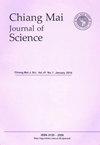通过棒磨工艺从酸再生工厂(ARP)副产品中合成红色颜料并确定其特性
IF 0.6
4区 综合性期刊
Q3 MULTIDISCIPLINARY SCIENCES
引用次数: 0
摘要
酸再生工厂(ARP)产生的氧化铁废料通常因其非营利性而被丢弃。本研究旨在引入一种增值工艺,通过棒磨工艺将氧化铁废料转化为红色颜料。从 ARP 收集的氧化铁废料用棒磨机以每分钟 30 转的转速研磨 24 小时。然后将研磨产品与工业级红色颜料按不同比例混合。然后将混合样品再次棒磨成超细颗粒。总共制备了七个样品,将其涂在画布上,并用能量色散 X 射线光谱法(EDX)和 X 射线衍射法(XRD)进行分析。通过分析,确定了氧化铁的存在、成分和取向。随后,在扫描电子显微镜(SEM)平台上对废物衍生红色颜料进行了粒度分析,结果显示了棒磨工艺的效率。使用色度计的 L*a*b* 系统对涂布前后样品的颜色相关特性进行了研究。经验结果表明,a* 值在确定样品的红度方面起着重要作用。总的来说,所获得的 a* 值都在 15 以上,并且随着工业级红色颜料添加量的增加而逐渐增大。此外,还通过吸油率测试对红色颜料的吸油率进行了检测。检测结果表明,颗粒大小和孔隙率会影响颜料的吸油量。本文章由计算机程序翻译,如有差异,请以英文原文为准。
Synthesis and Characterization of Red Pigment from Acid Regeneration Plant (ARP) By-product Via Rod Milling Process
Iron o xide waste from acid regeneration plants (ARP) is often discarded due to its non-profitability. This research aims to introduce a value-added process to convert iron oxide waste into red pigment via rod milling process. The iron oxide waste collected from ARP was grinded with a rod milling machine at 30 rpm for 24 hours. The ground product was then mixed with industrial-grade red pigment in various ratios. The mixed samples were then rod-milled again into ultra-fine particles. A total of seven samples were prepared, applied onto a canvas and analysed by energy dispersive X-ray spectroscopy (EDX) and X-ray diffraction (XRD) methods. From the analyses, the existence, composition, and orientation of iron oxide were established. The waste-derived red pigments were subsequently subjected to particle size analysis on a scanning electron microscopy (SEM) platform, with results showcasing the efficiency of the rod milling process. Colour-related properties of the samples before and after canvas application were investigated using the L*a*b* system with a chromameter. Empirical outcomes indicated that the a* value plays an important role in determining the redness of the sample. Overall, the a* values obtained were above 15 and gradually increased in accordance to the amount of industrial-grade red pigment added. The oil absorptivity of red pigments was also tested via an oil absorptivity test. Notably, the assay signified that particle size and porosity affect the amount of oil that can be absorbed by the pigment.
求助全文
通过发布文献求助,成功后即可免费获取论文全文。
去求助
来源期刊

Chiang Mai Journal of Science
MULTIDISCIPLINARY SCIENCES-
CiteScore
1.00
自引率
25.00%
发文量
103
审稿时长
3 months
期刊介绍:
The Chiang Mai Journal of Science is an international English language peer-reviewed journal which is published in open access electronic format 6 times a year in January, March, May, July, September and November by the Faculty of Science, Chiang Mai University. Manuscripts in most areas of science are welcomed except in areas such as agriculture, engineering and medical science which are outside the scope of the Journal. Currently, we focus on manuscripts in biology, chemistry, physics, materials science and environmental science. Papers in mathematics statistics and computer science are also included but should be of an applied nature rather than purely theoretical. Manuscripts describing experiments on humans or animals are required to provide proof that all experiments have been carried out according to the ethical regulations of the respective institutional and/or governmental authorities and this should be clearly stated in the manuscript itself. The Editor reserves the right to reject manuscripts that fail to do so.
 求助内容:
求助内容: 应助结果提醒方式:
应助结果提醒方式:


